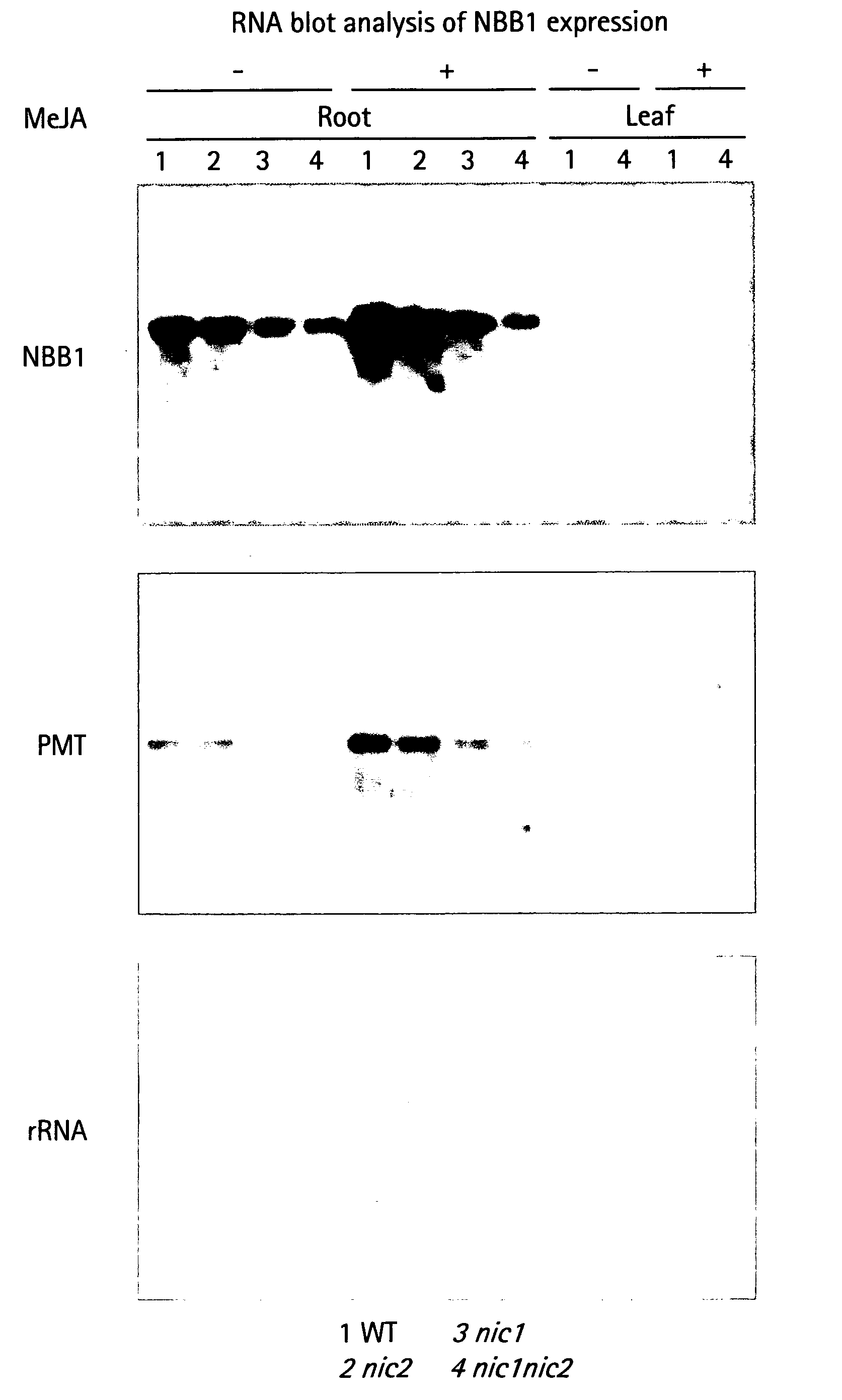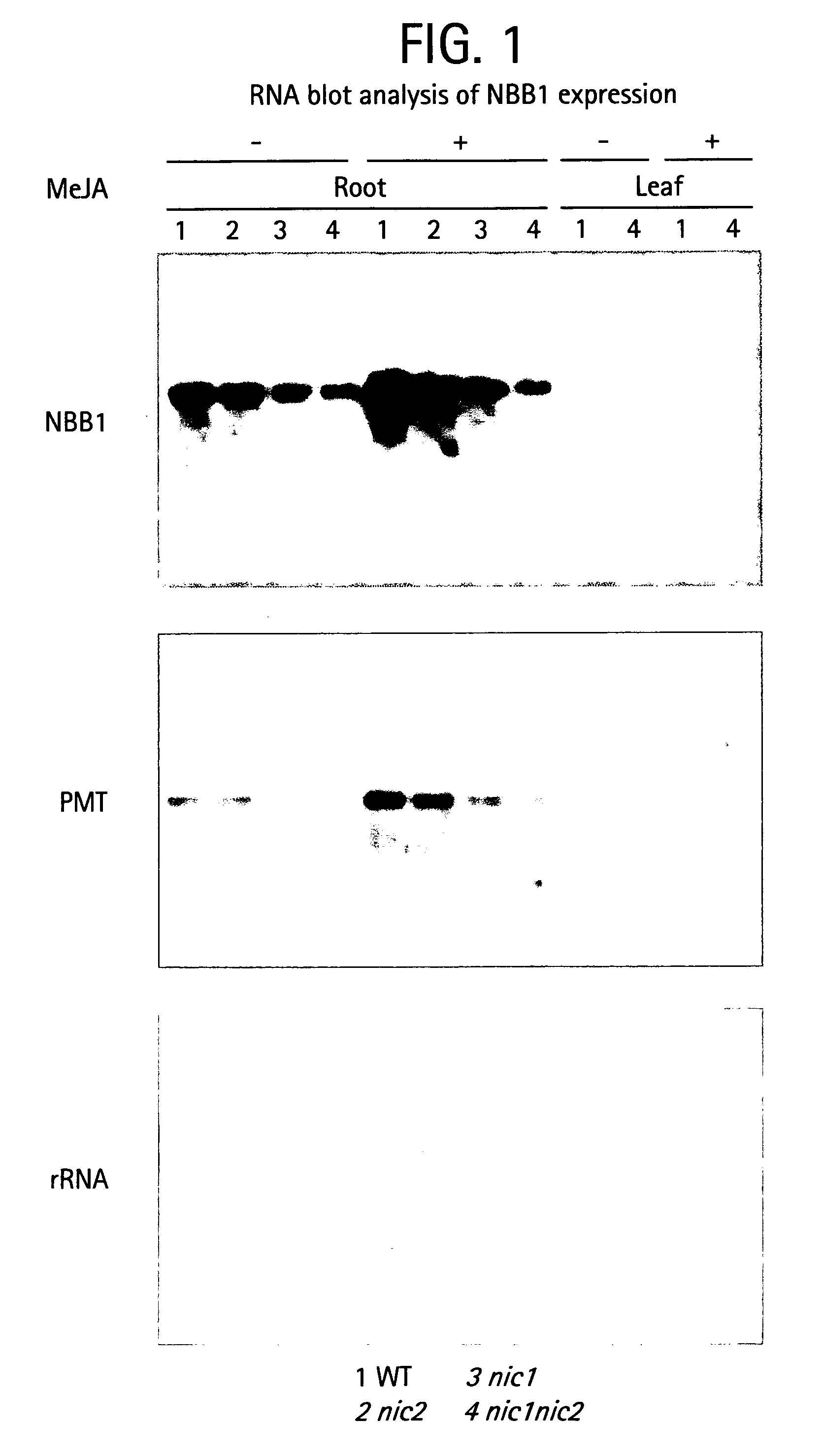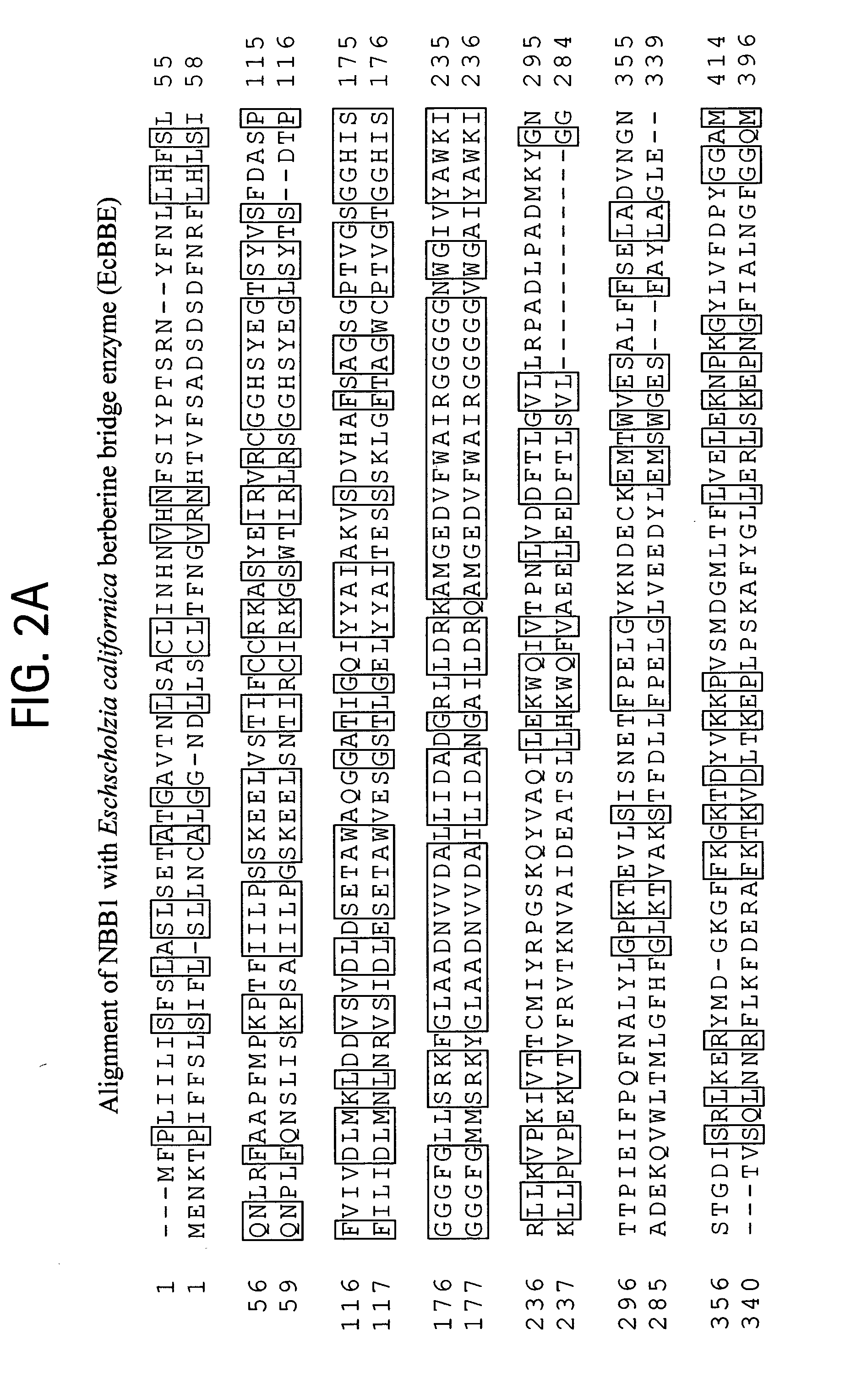Increasing levels of nicotinic alkaloids in plants
a technology of nicotinic alkaloids and plants, applied in biochemistry apparatus and processes, tobacco treatment, tobacco, etc., can solve the problems of insufficient up-regulation data, insufficient nicotine biosynthesis research, and insufficient nicotine biosynthesis, so as to increase nicotine and yield, increase nicotine synthesis, and increase yield
- Summary
- Abstract
- Description
- Claims
- Application Information
AI Technical Summary
Benefits of technology
Problems solved by technology
Method used
Image
Examples
example 1
Identification of NBB1 as a Gene Regulated by the NIC loci
[0195]A cDNA microarray prepared from a-Nicotiana sylvestris-derived cDNA library, see Katoh et al., Proc. Japan Acad. 79, Ser. B: 151-54 (2003), was used to search for novel genes which are controlled by the nicotine biosynthesis regulatory NIC loci.
[0196]N. sylvestris cDNAs were amplified by PCR and spotted onto mirror-coated slides (type 7 star, Amersham) using an Amersham Lucidea array spotter. DNA was immobilized on the slide surface by UV crosslinking (120 mJ / m2). N. tabacum Burley 21 plantlets (WT and nic1nic2) were grown on half-strength B5 medium supplemented with 1.5% (W / V) sucrose and 0.35% (W / V) gellan gum (Wako) in Agripot containers (Kirin).
[0197]Roots of eight-week-old plantlets were harvested, immediately frozen with liquid nitrogen, and kept at −80° C. until use. Total RNA was isolated using Plant RNeasy Mini kit (Qiagen) from the frozen roots, and mRNA was purified using GenElute mRNA Miniprep kit (Sigma). c...
example 2
Characterization of NBB1
[0200]NBB1 expression in tobacco plants was investigated by Northern blot analysis.
[0201]Plants of Nicotiana tabacum cv. Burley 21 (abbreviated below as WT) and mutant lines in which nic1, nic2 or both nic1 and nic2 mutations had been introduced in the Burley 21 background were grown in vitro for 2 months at 25° C. with 150 μmole photons / m2 of light (16 h light, 8 h dark) on ½×B5 medium with 3% sucrose and 0.3% gellan gum. The plants were treated with methyl jasmonate vapor by adding 0.5 mL of 100 μM methyl jasmonate to an Agripot container (Kirin, Tokyo) with a solid medium capacity of 80 cm3 and a gas capacity of 250 cm3 containing the plants. The treatment times were set at 0 h and 24 h. The root parts and leaf parts (2nd through 6th leaves from a plant body with a total of 7 to 10 leaves) were collected from the plant bodies and immediately stored frozen using liquid nitrogen.
[0202]RNA was extracted using an RNeasy Midi Kit (Qiagen) according to the manuf...
example 3
Phylogenetic Analysis of NBB1
[0208]NBB1 polypeptide has 25% identity and 60% homology to the Eschscholzia californica berberine bridge enzyme (BBE). Dittrich et al., Proc. Nat'l Acad. Sci. USA 88: 9969-73 (1991)). An alignment of the NBB1 polypeptide with EcBBE is shown in FIG. 2.
[0209]A phylogenetic tree was constructed using the sequences of NBB1 polypeptide and plant BBE-like polypeptides, based on Carter & Thornburg, Plant Physiol. 134: 460-69 (2004). The phylogenetic analysis was performed using neighbor-joining method with the CLUSTAL W program: Numbers indicate bootstrap values from 1,000 replicates. The sequences used were: EcBBE, California poppy BBE (GenBank accession no. AF005655); PsBBE, opium poppy (Papaver somniferum) probable reticuline oxidase (AF025430); BsBBE, barberry (Berberis stolonifera) BBE (AF049347); VuCPRD2, cowpea (Vigna unguiculata) drought-induced protein (AB056448); NspNEC5, Nicotiana sp. Nectarin V (AF503441 / AF503442); HaCHOX, sunflower (Helianthus ann...
PUM
| Property | Measurement | Unit |
|---|---|---|
| temperature | aaaaa | aaaaa |
| temperature | aaaaa | aaaaa |
| temperature | aaaaa | aaaaa |
Abstract
Description
Claims
Application Information
 Login to View More
Login to View More - R&D
- Intellectual Property
- Life Sciences
- Materials
- Tech Scout
- Unparalleled Data Quality
- Higher Quality Content
- 60% Fewer Hallucinations
Browse by: Latest US Patents, China's latest patents, Technical Efficacy Thesaurus, Application Domain, Technology Topic, Popular Technical Reports.
© 2025 PatSnap. All rights reserved.Legal|Privacy policy|Modern Slavery Act Transparency Statement|Sitemap|About US| Contact US: help@patsnap.com



